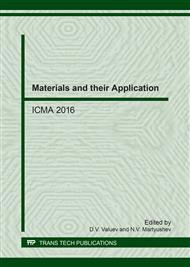[1]
A. Seelich, V. Syzrantsev, Theoretical and experimental research of Novikoff gear shaving. Proceedings of the International Conference on Gearing, Transmissions, and Mechanical Systems: 3-6, July 2000, Nottingham Trent University, UK. - P. 143-150.
Google Scholar
[2]
A. Seelich, Cylindrical of Novikoff's gear. Geometric calculation technique: monograph. – Publishing LAP (Germany), 2013. – 90 p.
Google Scholar
[3]
A.A. Lasukov, Selection of machining conditions in terms of the temperature dependence of chip formation, J. Russian Engineering Research. 35 (2015) 679-681.
DOI: 10.3103/s1068798x15090129
Google Scholar
[4]
S.A. Vasin, A.S. Vereshchaka, V.S. Kushner, Metal cutting. Thermomechanical approach to the system of interrelations when cutting: Textbook for technical higher educational institutions. M.: MSTU named after N.E. Bauman publishers (2001) 448 p.
Google Scholar
[5]
S.I. Petrushin, R.K. Gubaydulina, S.V. Grubiy, A.V. Likholat, On the Problem of Wear Resistant Coatings Separation From Tools and Machine Elements, J. IOP Conference Series: Materials Science and Engineering. 91 (2015) 1-7.
DOI: 10.1088/1757-899x/91/1/012048
Google Scholar
[6]
V.A. Petrova, A.A. Bakanov, A.V. Walter, Crack resistance of weld seals, hardening methods and composite tools quality, J. Applied Mechanics and Materials. 682 (2014) 431–437.
DOI: 10.4028/www.scientific.net/amm.682.431
Google Scholar
[7]
V.P. Astakhov, S.V. Shvets, M.O. Osman, Chip structure classification based on mechanics of its formation, J. Journal of Materials Processing Technolog. 71 (1997) 247 257.
DOI: 10.1016/s0924-0136(97)00081-2
Google Scholar
[8]
V.V. Brukhov, Improving the tool wear resistance with ion implantation method, Tomsk: STL publishers (2003) 120 p.
Google Scholar
[9]
D.V. Valuev, V.I. Danilov, Yu.F. Ivanov, On the causes of formation of non-optimal structures in a pressure-treated low-carbon steel, J. Russian Physics Journal. 50 (2007) 964-968.
DOI: 10.1007/s11182-007-0140-2
Google Scholar
[10]
A.A. Lasukov, A.A. Mokhovikov, Influence of modified layer of tool on stress – Strain state of cutting wedge Proceedings – 7th International Forum on Strategic Technology, IFOST (2012).
DOI: 10.1109/ifost.2012.6357720
Google Scholar


